Pte Clarence Richard Vaise (B 162460) (1925–45)
Introduction
The battle of Veen has preoccupied me since last February. I am working on a text and will post it when finished. As I have previously mentioned, I have perused the files of all the Argylls killed that day. The simple fact that two black Argylls died at Veen and two more were captured has been overlooked and not, I should add, deliberately so. Recent reinforcements were often unknown to the post-war veterans’ association, which had their geographical bases in Hamilton and Toronto. Over 3,300 men served in the wartime battalion; over 800 went into battle in July 1944. That number was decimated by battle and the unit reinforced continuously from September 1944 to April 1945 [see Pte Alexander Nickoloff and LCpl Frederick Woodward Jr]. Often – too often – recent reinforcements became early casualties [see Pte Wilfred Ernest Madaire]. As a result, they were often unknown to the veterans’ organization. In the 1980s and the 1990s, the Black yesterdays project relied on their list and the assistance of the veterans themselves to establish contact for interviews. Moreover, because of privacy legislation, the records of the fallen were closed to general research, although we received permission to do some quantitative sampling of records. The records of the fallen were not only opened up, but also digitized and made available through Ancestry.com. This fact and the proliferation of genealogical information on the Internet have opened an area for research unavailable even ten years ago. Thus, I can read the files of the Argylls killed on 7 March and learn something about their identities – religious, ethnic, or racial – plus, depending on the file, a lot of other information: familial, educational, occupational, recreational, and personal. Yesterday, I wrote about the life of Pte Edward Robertson Smith, today it is Pte Clarence Richard Vaise’s turn.
I am grateful to Patrick Brode, a lawyer and independent scholar in Windsor, for his assistance.
Robert L. Fraser
Regimental Historian
Death in battle is different, Sam Chapman thought:
“He is cut down in an instant with all his future a page now to remain forever blank.
There is an end but no conclusion.”
– Capt Sam Chapman, C and D Coys
Pte Clarence Richard Vaise (1925–45) (B 162460)
KIA 7 March 1945
Little is known of Clarence Vaise’s life. What is known lacks certainty. His enlistment papers give his place of birth as Montreal and the date of birth as 5 August 1925. There is no evidence connecting him to Montreal other than his attestation paper at enlistment. Even his date of birth is uncertain. After his death, his foster mother, Mrs Daisy Craven, gave the date as 8 April 1925; she was as close to him as anyone. Both parents were born in Canada although he provided no specifics as to where or their names; at his enlistment in 1944, they were, according to him, “deceased.” In one of his army estate documents, Daisy Craven wrote: “N.B. This boy was placed in my care from the children’s Home here in Windsor and I was his Foster Mother.” He was single, had no children, and as for his parents, she noted: “Not Known.”
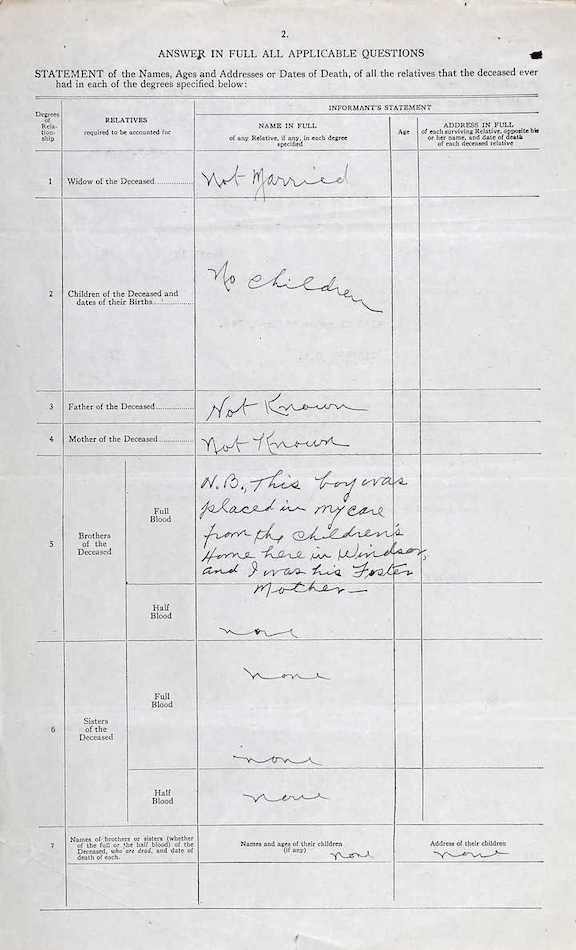 Statement by Pte Vaise’s foster mother, Mrs Daisy Craven, regarding his family.
Statement by Pte Vaise’s foster mother, Mrs Daisy Craven, regarding his family.
Vaise is an uncommon name. Pablo Vaise lived in Windsor, Ontario, in 1925. He was part of the city’s black community and boarded at 307 Assumption Street, the home of Joseph and Eliza Marshall, their daughter, Daisy May Craven (née Marshall), and her daughter, Cecil. Vaise was born in Bolivar, Venezuela, in 1901; in 1925, he was employed on the Wabash Car Ferry running between Windsor and Detroit. In February that year, after a verbal altercation with a fellow employee, they agreed to fight. Vaise pulled a gun and wounded the other man. It resulted in a trial before Mr Justice William Alexander Logie, one of the two founders of the 91st Canadian Highlanders and its first commanding officer. Whatever the result of the trial, the following year Vaise married Anne Amise in Detroit. They were living in Windsor in 1929, where, on 26 November, he “got unpardonably green-eyed” with jealousy over his wife’s putative “letter from a sweetheart across the river.” There was an argument, he shook her, and the police arrested him. He disappears from Windsor records after that date but continues to appear in ones for Wayne County with his second wife; he disappears from American records by 1944. It is possible that Pablo and Annie Vaise were Clarence Richard’s parents; that he was abandoned by them or removed from them; and then lived with Eliza Marshall (d. 1937) and later her daughter, Daisy Craven. By the time of his enlistment in 1944, Daisy Craven and her daughter were Clarence Vaise’s only familial connections.
Prior to his enlistment, Clarence lived near Bolton, Ontario, where he worked on the mixed farm of Mrs C. Wakely, who may have had a connection to Daisy Craven. He completed grade 9 and left at 17 because he did “not care for school.” Whether grade 9 was in Bolton or Windsor is unclear. He worked in Bolton for two years and two months before enlisting on 18 June 1944 in Toronto. He was single and his only next-of-kin was Mrs Daisy Craven, his stepmother who lived in Windsor; he did not support her. On his estate forms in 1945, Daisy wrote in the field pertaining to where he intended to make his permanent home: “here with me. 1048 Windsor Ave.” As for other relations, she put down her daughter, “Cecile Craven” and for “Other Relations,” Mrs C. Wakely, RR #3 Bolton.”
“negro”
Clarence Richard Vaise was 5’ 11,” 151 lb, with brown eyes and black hair. As for “Identification marks and scars, Maj Charles Newell, the army surgeon examining him, wrote: “negro.” Vaise had no intention of returning to farming after the war and had his sights set on “radio service.” He had no previous military training and was listed as a Baptist. Vaise’s short life reveals itself fullest in the various forms in his army personnel file. Notable is his ability to move army personnel selection officers; indeed, he never failed to stir them and to elicit their approval of his ability, his promise, his intelligence, his character, and his attitude.
“quiet, determined chap of good character and background”
The first army examiner commented extensively on Vaise in the space for his “Other Personal History and Appraisal”:
Vaise is a tall, well developed Negro of a good physique and very neatly dressed. He was raised in the city of Windsor by foster parents who gave him a good home. He had one step-sister only.
He is active in sport of all kind but excells [sic] in tennis. Has been a member of boys organizations and appears to have made good social adjustment despite some natural shyness. Reads extensively.
Vaise appears to be [a] quiet, determined chap of good character and background.
He has an excellent vocabulary, is courteous and has average learning ability. He is very well read and well informed on matters of general interest. Because of his shyness and reserve he may find difficulty in adjusting to army life but has possibilities of making a good dependable soldier.
The recommendation, especially by June 1944, was obvious: “C.I.C. [Canadian Infantry Corps] RIFLE Suitable for normal training.” After enlistment, he transferred to #20 Basic Training Camp (BTC) in Brantford. The experience of infantry battalions fighting in Italy had proven the need to steer recruits towards the infantry; casualties were high and units would need reinforcements.
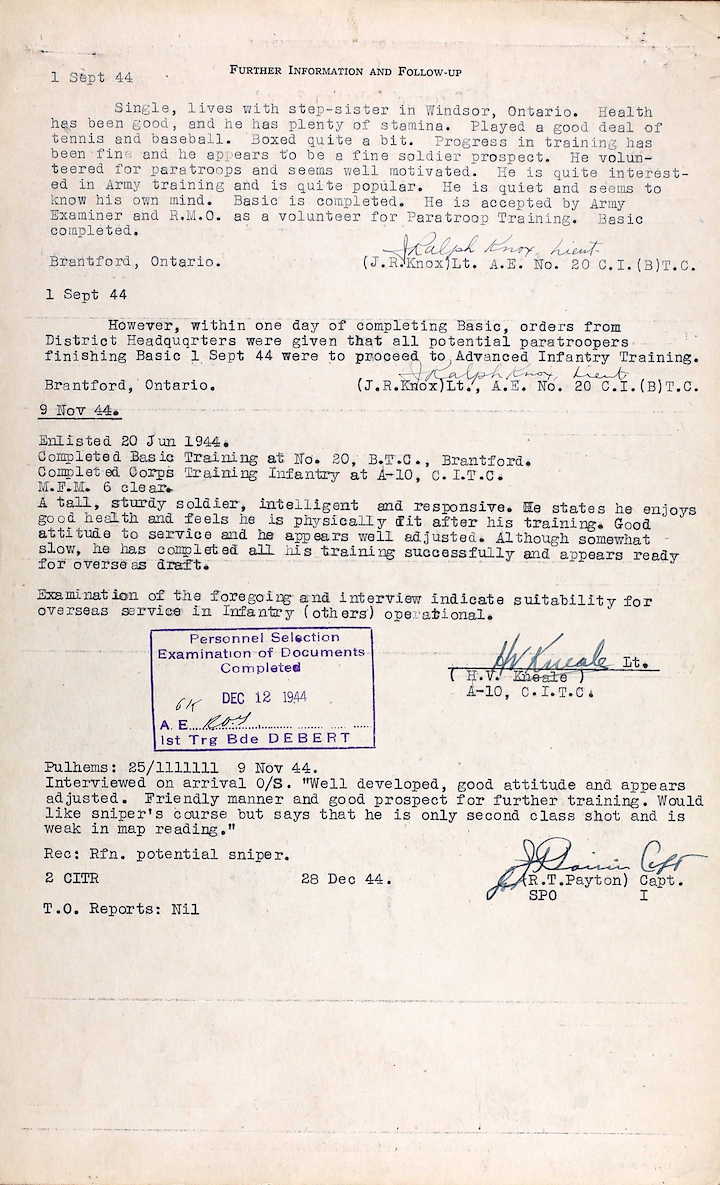 PSB follow-up, Pte Clarence Richard Vaise.
PSB follow-up, Pte Clarence Richard Vaise.
“a fine soldier prospect … well-motivated … quite popular”
Pte Vaise never failed to rouse army examiners. He was interviewed again, this time at Brantford, on 1 September 1944. Their favourable impressions made them unusually expansive, especially in later interviews:
Single, lives with step-sister in Windsor, Ontario. Health has been good, and he has plenty of stamina. Played a good deal of tennis and baseball. Boxed quite a bit. Progress in training has been fine and he appears to be a fine soldier prospect.
He volunteered for paratroops and seems well-motivated. He is quite interested In Army training and is quite popular. He is quiet and seems to know his own mind.
Basic is completed. He is accepted by Army Examiner and R.M.O. as a volunteer for Paratroop Training. Basic completed.
Vaise’s aspirations were squashed the same day because “orders from District Headquarters were given that all potential paratroopers finishing Basic 1 Sept 44 were to proceed to Advanced Infantry Training.” Taken off strength of #20 BTC on, he was taken on strength at A10 CITC in Camp Borden. There, on 25 September, he was “awarded” 14 days’ detention for “insubordination to the guard commander.” The next day Vaise was attached to No.86 Military Detention Barracks”; he was released on 7 October 1944.
Most Argylls had one or two minor infractions on their record. Insubordination was Vaise’s one and only. There is no record of what prompted it. One supposes that there was provocation; the act is a glaring exception to a spotless record replete with praise, and no one took further notice of it. On 11 November 1944, an examiner noted that “Boxing is [his] main sport – Builds Model planes for hobby.” He received a 14-day furlough as well as three days special leave from 17 November to 3 December 1944; presumably, he returned to Windsor. On 9 December it was noted: “No qual. as tradesman.” He embarked on 18 December and disembarked in the United Kingdom on 27 December and reported for duty the next day.
“A tall, sturdy soldier, intelligent and responsive”
The next interviewer was also taken by Pte Vaise. Again, the full impression bears notice:
A tall, sturdy soldier, intelligent and responsive. He states he enjoys good health and feels he is physically fit after his training. Good attitude to service and he appears well adjusted. Although somewhat slow, he has completed all his training successfully and appears ready for overseas draft.”
Here, the recommendation was entirely predictable: “suitability for overseas service in Infantry (others) operational.” If ever there was a designation that ensured combat, this was it.
“Well developed, good attitude … Friendly … good prospect for further training”
Once in the United Kingdom, Pte Vaise underwent yet another interview. The selection personnel officer was as positively influenced by the young soldier’s character, deportment, and attitude as were all of the others:
Well developed, good attitude and appears adjusted. Friendly manner and good prospect for further training. Would like sniper’s course but says that he is only second class short and is weak in map reading.
The interviewer’s conclusion was: “Rec: Rfn. Potential sniper.”
On 30 January 1945, Pte Vaise completed his “3 weeks Refresher” with 2 Canadian Infantry Reinforcement Regiment and went to the X-4 list (for unposted reinforcements). He “emplaned” in the UK on 17 February and “deplaned in N W Europe” the same day. He was taken on strength to the X-4 list (13 Bn) for unposted reinforcements on 22 February; the Argylls took him on strength on 1 March 1945 and posted him to B Company. Pte Don Pruner was one of the 54 reinforcements joining the battalion on 1 and 2 March. “We were practically all new,” he recalled about his platoon, “we’d all come up together, a bunch of reinforcements.” Capt Len Perry, officer commanding (OC) B Company, “was sort of fierce looking … And very intense, and sort of almost on a high.” He “was trying to give us a little backbone and a little … regimental inspiration and so on.”
From 1 to 6 March, the Argylls were non-operational. The weather turned colder. On 5 March, “after four days of unexpected activity,” the battalion left the Hochwald Gap and “concentrated in the general area of the woods, waiting for the word to proceed towards Veen,” a small village 6.4 km east of Sonsbeck. There was some mortar fire from the enemy, resulting in casualties in C Company. The Argylls spent the night of the 5th “in the woods, exposed to the pouring rain, sheltered in slight trenches.”
After Sonsbeck was captured on the 5th, the attack on Veen commenced. On 6 March at 0800, the forward element of a large, combined arms battle group moved out of the woods near Sonsbeck towards Veen. Today, the 6.4 km journey takes 8 minutes in light traffic. Seventy-five years ago, in March of 1945, conditions were different. There were five battle groups in the order of march, B Coy was in the fourth with “under command one troop of SP [self-propelled] anti-tank guns.” The leading group included C Squadron of the South Alberta Regiment’s tanks and C Company of the Argylls. From that time until 1400 hrs, progress was delayed by mines, the “impassable condition of the ground even for tracked vehicles,” and a huge crater in the road from Sonsbeck to Veen. Lt-Col Wigle ordered C Company to dismount from their Kangaroos and advance on foot. At 1600 hours, with the crater filled, the battle group advanced until stopped “by very heavy machine gun fire, mortar concentrations and SP [self-propelled guns] fire.” It proved “too much” for them to handle. One tank was brewed up, as was a Kangaroo. Wigle went forward at 1800 hours and returned at 1900. Brigade ordered him “to capture Veen before first light.” C Company had six wounded in the late afternoon/early evening; there were also two casualties in the Pioneer Platoon.
The CO called an orders group; he had decided upon a night-time infiltration with B and D Companies. The night was dark, the route not reconnoitred, there was no tank support and limited artillery support, the infiltration would follow a creeping barrage (difficult with experienced, well-trained troops and problematic with companies composed largely of recent reinforcements), the outer and inner defences were well fortified, the enemy (paratroopers) was well equipped and determined, and the communications between the companies and tactical headquarters sporadic.
The companies crossed the start line at 0100 hours on the 7th. Coordination with the creeping barrage proved thorny; D Company had casualties from friendly fire, including one Argyll killed, and in the confusion elements from D Company became mixed up with B. Inexplicably, there were also Argylls from C Company [see Pte Ernest Robertson Smith] and also from Support Company. In time, B’s 18-set broke down and Capt Leonard Perry, the officer commanding B Company, had no communication with Lt-Col Wigle. For his part, Wigle could not determine the locations of either company in the ensuing hours. The night was as “black as shit,” as Pte Peter Leslie Ginn from Newfoundland later told his son. One of B’s three platoons became lost; one platoon (possibly just a section of a platoon) from D lost contact with the main elements of D. Argylls from both companies stumbled into Germans in the dark (some Germans were captured and vice versa). Pte Vaise spent his last six hours in the dark, the cold, and the terror of battle that night.
“he [Perry] was going in” – Capt Sam Chapman, D Coy
Chapman and Perry conferred. Their accounts of the conference differ as did their plans for next steps. Chapman considered the situation hopeless and proposed asking Wigle for permission to withdraw:
I met Perry later on … we decided that … he’d take a run at it [Veen] and I’d stay. And if he got into the town, he’d take up a position and I’d come in and try to go through … my position was that we should both ask for permission to come out. He responded by saying that he was going in.
Perry made no mention of Chapman’s plan to withdraw; Perry downplayed the risk and favoured an attack:
I was conferring with Sam Chapman, trying to figure out how we could take the place … It really wasn’t even a town. It was about a dozen loosely scattered houses, farm buildings, and that sort of thing. I’m sure the whole population of Veen wouldn’t have been fifty people … And the last [communication with D Coy] was that I would [attack] in five minutes’ time. I would give it another grunt, I’ll try and get into this building, which was almost the centre of resistance …
“wanted to take ‘a run’ at the town”
Lt Herb Maxwell was adamant:
… [The] D Company commander [Capt Sam Chapman] and Captain Perry did confer. I was there. They did confer. And [the] D Company commander did say he was going back. The information that Perry did not get the message [to retire] is not correct. Perry did get the message … Why didn’t he withdraw? I can’t tell you that. We did go in. It wasn’t that much further from where we had met the D Company commander … I think we were down at least two miles into enemy territory.
Maxwell heard the OCs disagree, but at that stage, they did not have permission to withdraw nor, apparently, had Chapman requested it. Rather, he intended to ask if Perry concurred and he did not. Chapman, an officer with considerable field experience, thought the companies’ position untenable and concluded that withdrawal was the only sensible plan. Perry disagreed and wanted to take “a run” at the town and, if they succeeded, Chapman would “try to go through.” The alternatives were clear: Perry took one, Chapman the other. Whether Perry wanted D Coy to attack as well is not known. Whether he suggested it or not is another unknown; it is unlikely that Chapman would have agreed.
If the original battle group that set out at 0800 on 6 March – three infantry companies (C, B, and D) with two squadrons of SAR tanks (C and B) along with one troop of SP guns and artillery support – had failed to breach Veen’s defences, it strains credulity to understand how two platoons from B Coy might find success. There was no chance of surprise because the Germans knew they were there; they had already taken prisoners from both companies. Worse for B, Perry had no means of communicating in real time either with Chapman or Wigle.
B’s two platoons moved out. At this point, B Company had probably not taken any casualties. It is almost certain that Pte Vaise was with 10 or 11 Platoon of B. Over 45 years later, the move was acid-etched in Lt Maxwell’s memory:
We started just about – I’d say single file – down through a long field, going right down slowly … When we got about halfway down, we were challenged. It was just to the right. And we just stayed very quiet, said nothing, waited a little while, then just kept going. We bypassed that fellow. And we got down to an area … There seemed to be … a little creek – not a very big creek – just a little creek you had to step over. And then right here, in this area, were very, very deep weapon traps or tank traps or trenches … but then in front of us was a huge barn building, just up across, a huge barn building. And just as we got down to the junction of this creek, a German soldier wrapped his arms around me and yelled, “Kamerad! Kamerad!” … He had my arms pinned right to my sides … and I was trying to get them loose. Anyway, there was a couple of soldiers with us and one of the fellows said to me, “Will I shoot him, sir?” I said, “Oh my God, no!” So we didn’t quite know what to do because Perry wanted us to move forward, and I don’t really remember what they did about that German boy. But I said to those two fellows, “You stay with him, take his weapons away from him. Stay with him, go back a little bit just on this path that we came down, and stay there.” And I said, “See how the situation goes, and if things go badly, try to get back to the unit with him,” for information…
“And we got into this deep ditch, and I think we sort of formed up there again”
Pte Ken Brimacombe, 10 Platoon, remembered it as the spot where the two platoons formed up again:
… we went up and as I can remember, we went past this farmhouse … and it seemed to me we come up to another farmhouse [that] was on the right, and we made a left turn up there and there was a deep ditch. And I think it was alongside of a roadway … And we got into this deep ditch, and I think we sort of formed up there again.
Pte Donald MacPherson, 11 Platoon, was the company runner that night. Perry sent him out twice, presumably after the two platoons had reached the area of the tank traps and trenches. MacPherson had two missions from this position: “first to find ‘D’ Company and secondly to find our missing Platoon [12 Platoon] … and … I met with no success, which isn’t surprising, because I had not the slightest idea where to look.”
“out-gunned”
B Company was on its own: two platoons rather than three; no communication with D Coy or Tac HQ; no idea exactly where it was; no artillery support; no hope for reinforcement; “out-gunned”; and with no prospect for success against a heavily fortified, albeit small, area defended by elite troops. To make matters worse, the Germans were aware of their presence. Several Argylls were captured between 0230 and 0400 hours.
The Germans occupied a “shallow trench” about 50 or 60 yards from the edge of town. At some point after B Coy’s arrival opposite them, they withdrew into the town, whereupon B occupied the vacated trench that became the base for the final attack.
“it was perfectly obvious that our position was hopeless” – Pte Donald MacPherson, 11 Platoon
The Argylls were then occupying the vacated German trenches. Forty years later, Chief Justice Donald MacPherson of Saskatchewan (then Pte MacPherson of 11 Platoon), described the situation and evaluated the circumstances:
There was a sort of shallow trench about 50 or 60 yards from the edge of the Town of Veen, and when we made our two-Platoon attack, that trench was occupied by some German soldiers who immediately withdrew into the Town whereupon we occupied the trench and some nearby shell holes. I was in a shell hole on the far right of our position, and in the dark, could make out the rest of our troops in the shallow trench to our left. Along with me in the shell hole were my friend Lance Corporal Henry Montgomery (we had joined the Army together in Regina in the Spring of 1943) and Sergeant A.A. Smith (“Smitty”). Smitty had become our Platoon Sergeant following the Hochwald Battle during which our then, and long time, Platoon Sergeant, Joe Rowley, was wounded. We were subject to heavy machine gun fire from the buildings of Veen.
To me, with the questionable wisdom of a mere private, it was perfectly obvious that our position was hopeless, that we were outnumbered and outgunned and that we had not a hope in Hades of capturing the Town. With my child-like logic, I assumed we would hold out until just before dawn and then withdraw, reorganize with the rest of the Regiment, arrange for adequate tank support, and then make a proper attack on the Town later that day or the following night.
It is difficult to pinpoint timings because most accounts indicate simply whether it was dark or light or something in between. Sunrise occurs about 0640 hours there in March; it starts to lighten an hour or so before the leading edge of the sun is first visible. Perry states that “it was getting quite close to light when we went into that last assault” – 0600 hours perhaps? Pte Ken Brimacombe, 10 Platoon, placed the final attack “like daytime, almost – like twilight or something.”
There is no evidence that Perry consulted with either Lt Maxwell before his decision to attack. The platoons were under heavy fire and returning it. Perry, himself, whose memory of Veen was considerably less acute than his memory of the Hochwald, provided no hint of his decision-making process. In his interview, he refers to it simply as “the final assault.” Perry made a curious comment that a company OC could not affect events:
… you can say all you like, but a company commander can’t control the troops to any degree once you’re committed to a particular battle. It’s then up to the individual platoon commander and section commander to use his head and do the best he can, because it’s beyond the capacity of the company commander to really take any control other than to maybe a section nearest to him …
It was his decision, however, to attack, his alone. Moreover, whatever impelled him to charge, whether emanating from impulse or reflection, it was his resolve and his responsibility, his alone.
“Perry climbing out of the trench and yelling ‘Charge’!” – Pte MacPherson
The post-action report by Capt Pogue and L/Sgt Snudden provides a truncated overview:
One large bomb crater, which figured largely in this action, was in the hedge, cutting and removing a portion of the same. When the attack went in, 10 platoon was leading and when near the centre of the field, part in the open and part going along the hedge they came under very heavy fire from the building. This fire was all small arms, machine gun, bazookas, and some hand grenades, with a few flares. This platoon suffered casualties so 11 platoon was sent into the same positions with them.
From the perspective of those on the ground, it was much more dramatic. Pte MacPherson, 11 Platoon, describes what happened evocatively:
Then, to my soul-shaking shock – and with abject fear – I observed Captain Perry climbing out of the trench and yelling “Charge!”, and the troops from the trench joining him. Smitty shook his head and said “Well fellows, I guess we gotta go”, so the three of us joined the charge – Montgomery and I on either side of Smitty. We hadn’t advanced 10 yards when a withering fire came from the Town hitting a number of our troops and causing us to hurriedly return to our trenches and shell holes. Smitty received a diagonal row of Schmeisser button holes across his upper body; Montgomery and I hauled him back into our shell hole where he died within a few minutes.
“Go, Argylls, go!”
Pte Brimacombe’s (10 Platoon) description is graphic and compelling:
… I guess it was Perry decided that we’d charge. ’Cause up in front there was … a big house, a big building up at the end, a big brick building … So I can remember then that we did make a charge and we were spread out across this field and I don’t know how they rallied the guys that we would make a charge. I guess somebody passed the word or I guess Perry. But Perry was there, [Lt Herb Maxwell] was there … There were some people behind us … we were firing everything we had and, in fact, we were all yelling like banshees … I remember yelling, “Go Argylls, go!” I was screaming this. The other guys were shouting, eh, ‘cause … you’re like a wild man, I’ll tell you. You’re not like you are today. You’re just a goddamn wild man. Your principles are almost gone …
… it [the objective] was a trench … their zig-zag trenches that they dug all the time. And all the dirt had been thrown over this side, ‘cause that was the side we’d be coming from … And we climbed over this dirt and down into the trench. Maxwell was on the right, Perry was on my left, I was in between them … I can remember one guy on the left … He must have been from Northern Ontario, deer hunting country or something, because he lifted up his rifle – his Lee Enfield – and he just followed [a fleeing German] … He just followed that guy and pulled the trigger and the guy dropped … I fired all the ammunition I had, all the magazines I had, and I got some from other people, I guess … we still had grenades hanging on our belts, on our web belts. And I can remember throwing the grenades, and Perry too … at this goddamn building trying to hit the openings in it. Whether or not we did, I don’t know … Threw all our grenades, and I had no more ammunition and nobody had any more ammunition. Maybe somebody had one or two rounds, I have no idea. But the Bren gun was done …
“All of a sudden all hell breaks loose” – Pte Ernest Wilfert, D Coy Pte Wilfert participated in the charge. In the early morning confusion at the start line with the creeping artillery barrage, he, along with several others from D, “got lost from my company” and ended up with B (presumably 11 Platoon):
So Sergeant [Alexander A.] Smith … was at the head of the column and the hedge alongside of us. We’re going up towards this building. All of a sudden all hell breaks loose and all you can see is tracer bullets coming right at you … There was a big shell hole and … Sergeant Smith got past that. He got pretty close to the building and he was killed there.
The Germans drove back the foolhardy charge with withering fire. Back in the shallow trench or shell holes, the remaining Argylls continued to fight. Lt Maxwell held out some hope that anti-tank rounds from the PIAT (Project, Infantry, Anti-Tank) might help. As a result of the attempt, he sustained serious wounds:
… we got over into the deep trench and there was a young fellow there … said he had never fired a Piat bomb gun before. I didn’t believe him – I really don’t believe him to this day – but he said he didn’t know anything about it and didn’t know how to fire it. So anyway, to make a long story short, I fired the eighteen Piat bombs myself [at the] barn … And then the eighteen Piat bombs were gone and I sent back for the other nine. And a fellow came back and he said … “They haven’t got them”… or something. This was Jones’ platoon had got lost. And I made a mistake right then and there. I turned around and I yelled, “Send up those damn Piat bombs!” And just as I did that, they fired from the barn. And I imagine it was a rifle grenade … because it just hit the top of the high trench just as I turned around. And I put my arms [up] … I got a lot of shrapnel … And it broke my arm … But most of the explosion went down and hit me in the right knee, and I suppose I was out for a while …
Others began the journey back to the unit’s lines and some, such as Pte Wilfert of D, made it.
“Captain Perry decided to surrender the Company” – Lt Maxwell, 10 Platoon
From start to end, the battle for Veen was characterized by confusion. It proved true as well for the surrender. Herb Maxwell was emphatic on the subject. He had a heated discussion with Perry after being wounded:
And I think it was at that juncture that Captain Perry decided to surrender the Company … We [Maxwell and Perry] got into a real shouting match, I’ll be honest with you. I feel badly about it now, but I’m just telling you the truth. We quarrelled. I thought we should try to get out. Now, my thinking wasn’t very rational, because if they did get out, they would have had to leave me behind, I suppose. I don’t know how the hell I could’ve walked out…
… what could you use against that well-fortified building, you know? So Perry was right in one sense, that we were not going to make any … headway there. We either had to stay or get out, and my option would have been to get out, that’s all.
For his part, Pte Brimacombe presumed it was Perry’s decision:
… I presume that Perry surrendered because I can remember that we hollered “Kamerad, Kamerad” … And held our hands up. And … I threw the Bren gun down in the trench and stood on it to climb out of the trench, I can remember that … I can remember one fellow, his eye was hanging down on his cheek just held by the cords that are in behind your eye. Another guy, his jaw was hanging down on his chest. And these guys were standing up and walking around in a daze … And the medics, the German medics came out. Well we wrapped our arms around these guys … and shook hands, traded cigarettes … just like you do at the end of a football game and you meet your opposition. We were all there together. We lost and they won the game, that’s about the size of it …
Pte MacPherson (later in his life the Chief Justice of Saskatchewan) was unequivocal on the matter:
At first light, it seemed to me that about 1,000 German soldiers emerged from the Town (it was probably only about 100) yelling “Surrender” and firing over our heads. I anxiously watched Captain Perry and in a few moments was relieved beyond measure to see him wave something white and see all the troops from the trench rise with hands up. But Montgomery and I were concerned – we did not think the Germans realized that we were in the shell hole far to our right and we were greatly worried that if we were to suddenly and unexpectedly rise from our shell hole, that we would be fired upon. Neither of us could think of any white cloth that we carried with us until I recalled that when going through a vacated and heavily damaged house in Cleve, I had come across a white napkin which I purloined and used to wrap my cutlery inside my mess tins. I quickly extricated the napkin, tied it to the end of my sten gun, and we safely emerged.
“manifestly hopeless” – Maj Hugh Maclean
In his post-war account of the battle, Maj Maclean wrote that “what was left of the company” had holed up in shallow pits and ditches, at times as close as 50 yards from the houses. The entire area was “dominated by German fire from three sides. Movement of any kind was impossible; ammunition was almost finished.” “In view of this situation,” Maclean concluded, “Capt. Perry surrendered his little force.”
Perry had marked his copy of Maclean’s history and took umbrage at the words. His version of events differed markedly and emphatically from those of Maclean, Maxwell, and MacPherson:
We kept plugging away, trying to [move] forward. And somehow or other, everything went blank when I poked my nose up out of the slit trench to try and think what I was going to do next. And I suspect it was a grenade or … something went off fairly close to my stupid head … Yeah, I think I was probably unconscious for about half, 3/4 of an hour.”
He was still trying to figure out how to take Veen and had no thought of surrender. After the concussion from the grenade:
… it was almost dusky dawn when I was aroused from my gentle slumber. That kick in the rear was from a young paratrooper, “Raus! Raus!”… I don’t think it was even a question of [being] overrun. We were so intermingled with the German position … I was led [away] because I couldn’t see, until I got some water and a dirty sock or something and cleaned the blood out of my eyes.
I saw [Lt Herb] Maxwell later on that morning, at the [German] regimental aid post. But didn’t have any conversation with him. In fact, while I believe I was aware that he’d been hit … I wasn’t aware that he’d been seriously hit.
“guys laying across in the field, I guess they were dead”
After the surrender, the German paratroops treated the captured Argylls well. The wounded were treated and some, such as Pte Madaire and Lt Maxwell, were evacuated: Madaire died and Maxwell endured a horrible ordeal as his wounds became gangrenous; his leg was eventually amputated. As for the dead, they were left, it seems, where they were and their bodies later retrieved by the battalion. Pte Ken Brimacombe of 10 Platoon, B Company, was captured. He never forgot the sight:
… after we surrendered, and we were climbing out of the trench or we could get our heads up and look. I looked back and I could see guys laying across in the field, I guess they were dead. Maybe they weren’t all dead. Maybe some of them were still alive; but I could see these forms ’cause it was a fairly flat field for quite a good ways back …
About two months later, Sam Chapman told his wife that “I saw them lying all over the place … God but I’m glad it’s over.” He was “very low.” “It’s the only time that I can recall,” he said, “that I would have almost been relieved to be killed … I was just interested in doing what I … had to do and trying to keep as many people alive as I could.”
“a terrible mistake”
Fifty-one Argylls were killed, wounded and/or captured in the hours between 0100 and about 0700 on the 7th. Of that number, only 2 had been with the unit before 9 September 1944; 17 joined as reinforcements between 9 September and 29 November; and 32 were taken on strength between 9 January and 7 March (most arrived in February, many in late February/early March). Pte Vaise’s situation, as a very recent reinforcement, was by no means unique; 24 of them joined the unit between 28 February and 7 March. Of the 51, 22 were from B Coy; 21 from D; and 8 from other companies (6 from C Coy and 2 from Support). Of the 9 dead: 2 were from B, 2 from C, and 5 from D.
 Field service report for Pte Vaise, completed by Padre Maclean.
Field service report for Pte Vaise, completed by Padre Maclean.
Pte Vaise was one of B Company’s fallen. There are no extant letters or reminiscences offering clues as to when he was killed. B had casualties after it had occupied the German trench and before the charge. Undoubtedly, there were more at the charge and after it. At some point in that cold dawn, he died. As Padre Charlie Maclean wrote of Veen: “we found some dead around that position.” Maclean handled Pte Vaise’s burial and those of his comrades, as he had done for so many Argylls since the 29th of July. An Argyll piper played “Flowers of the Forest,” the battalion’s lament during the war, and young Clarence Vaise was temporarily laid to rest until he reached his final destination in the Canadian War Cemetery at Groesbeek. He left, in terms of his personal effects, almost nothing: a red identity disc, 1 crucifix, and 3 “souvenir notes.” In a letter written on 3 April, the army notified Daisy Craven of Pte Vaise’s death; the Windsor Star reported his death with the others who died that day. It referred to “Mrs Daisy Craven” as his “foster-mother” and his address as 1048 Windsor Avenue. On 18 April, she filled out the requisite estate forms.
 Newspaper clipping listing deceased, including Pte Clarence Richard Vaise.
Newspaper clipping listing deceased, including Pte Clarence Richard Vaise.
“black men in your regiment”
Veen was a failure and Lt-Col Wigle admitted it. It was not a failure of personal bravery; the Argylls had it in abundance on 7 March. It was a failure attributable to the inexperience of the commanding officer and the almost certain battle exhaustion of the B Company commander. Once captured, Perry was interrogated by a German officer who “spoke quite good English.” He commented on the black Argylls and drew his own conclusion as to the meaning of their presence. He said, “It is obvious you are short on men. You are having black men in your regiment” [Ptes William Courtney and George Johnson were both captured].
“what a sad futile loss of life had taken place”
About 20 years after the war, Perry returned to Veen and provided a fitting epitaph for the struggle there:
As I looked at the lovely little brook, which I had last seen as an anti tank ditch filled with barbed wire, and the peaceful cottages and farm buildings, I could not help thinking what a sad futile loss of life had taken place.
Sam Chapman’s meditation on Argyll deaths fits the lives of the fallen. It could, however, have been written with young Pte Vaise in mind, a young man of so much promise:
“all his future a page now to remain forever blank. There is an end but no conclusion.”
No image of Clarence Vaise is extant, and no relative ever visited his grave.
Between 1 March and 7 March 1945, 15 Argylls were killed in action, 32 wounded, and 32 POWs.
“a history bought by blood” – Capt Sam Chapman, C and D Coys
Remembered respectfully – An Argyll
Note: Pte Vaise’s poppy will be mounted in the virtual Argyll Field of Remembrance in the near future. The Argyll Regimental Foundation (ARF) commissioned Lorraine M. DeGroote to paint the Argyll Poppy (top) for the Field of Remembrance.
Robert L. Fraser
Regimental Historian

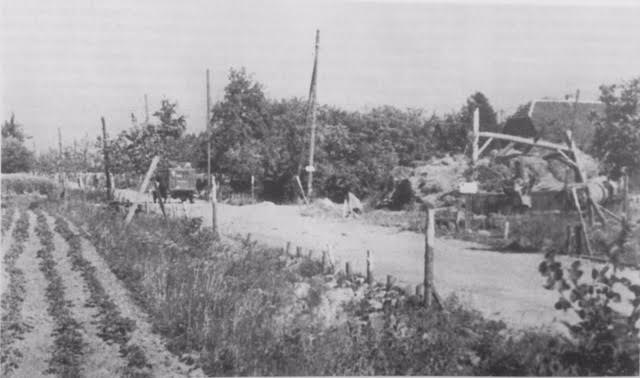 Main road to Veen from Sonsbeck, March 1945.
Main road to Veen from Sonsbeck, March 1945.
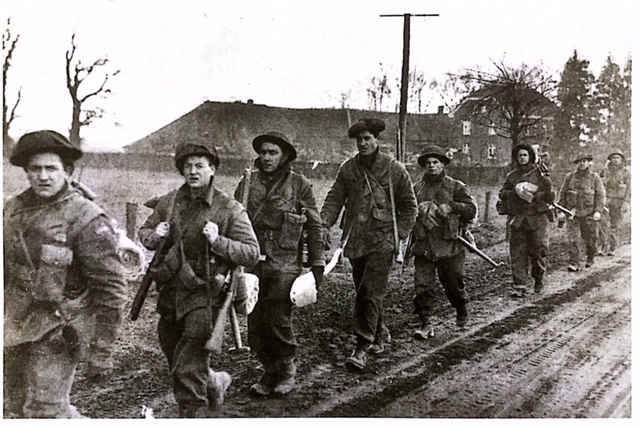 Argylls moving forward to Veen, 6 March 1945.
Argylls moving forward to Veen, 6 March 1945.
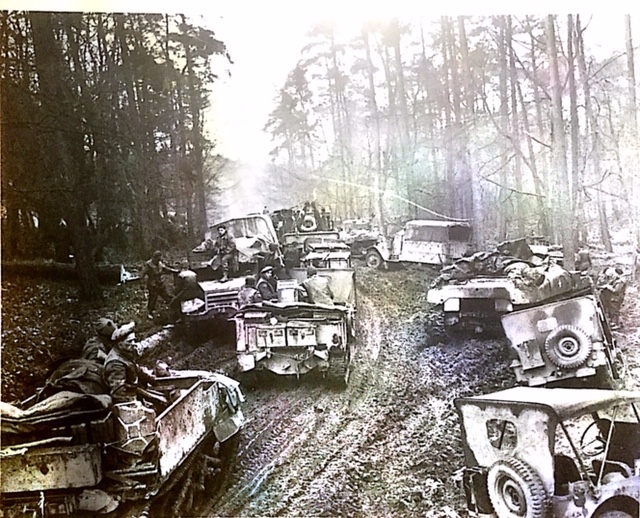 Argyll vehicles skirting Sonsbeck, 6 March 1945. Pte Gordon Penrose, a stretcher-bearer, is standing in the middle carrier facing the camera.
Argyll vehicles skirting Sonsbeck, 6 March 1945. Pte Gordon Penrose, a stretcher-bearer, is standing in the middle carrier facing the camera.
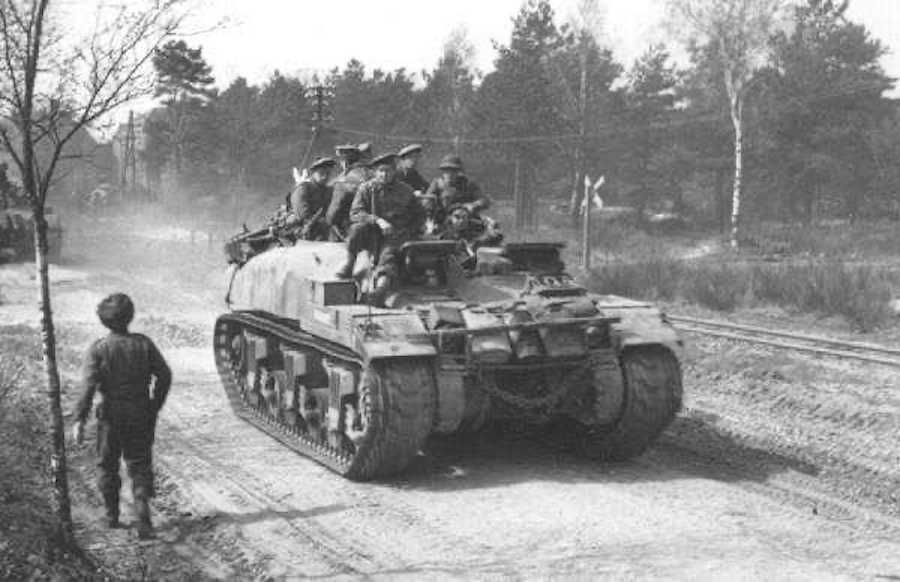 Argylls on Kangaroo (11 April 1945, Germany).
Argylls on Kangaroo (11 April 1945, Germany).
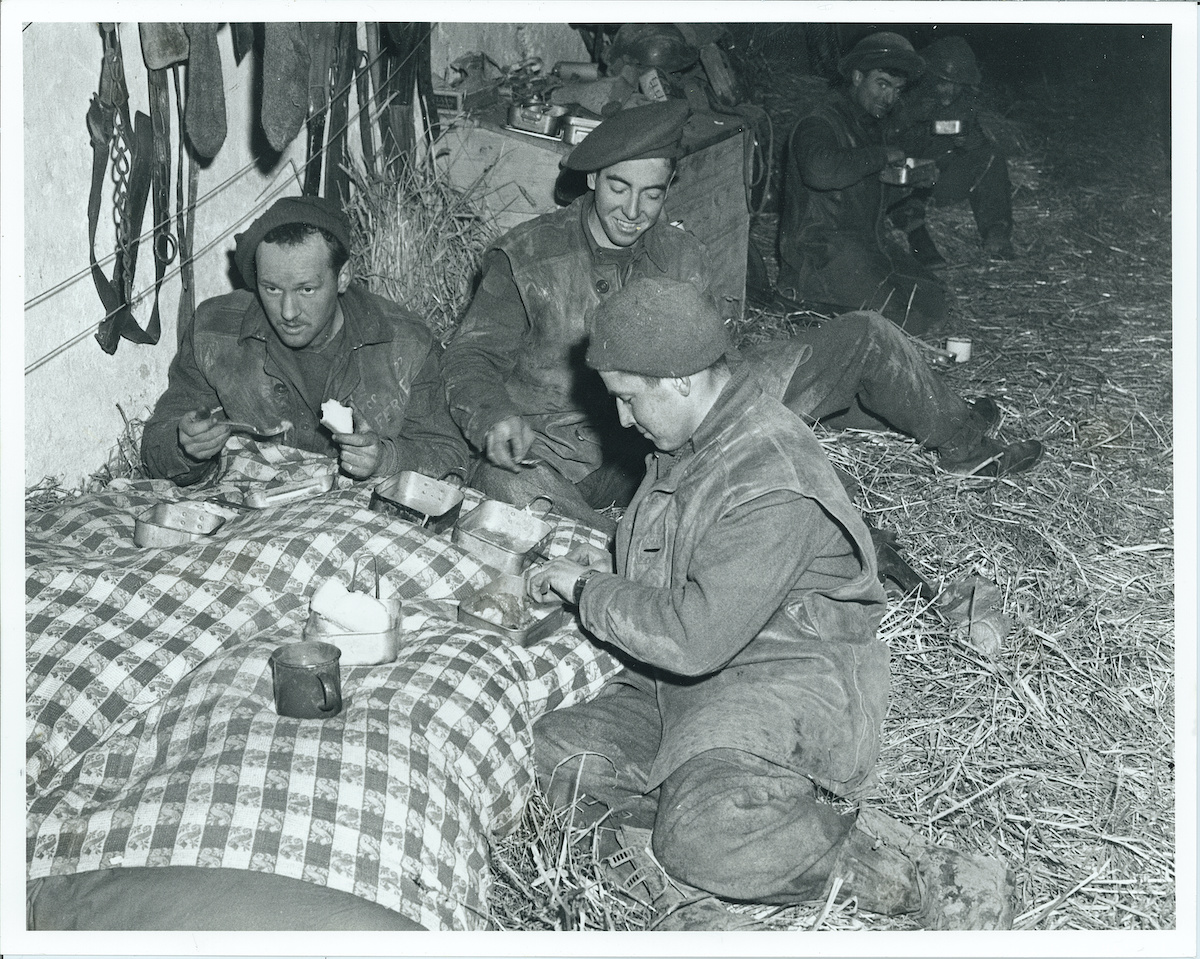 Argylls dine in style in a barn near Veen, 7 March 1945.
Argylls dine in style in a barn near Veen, 7 March 1945.
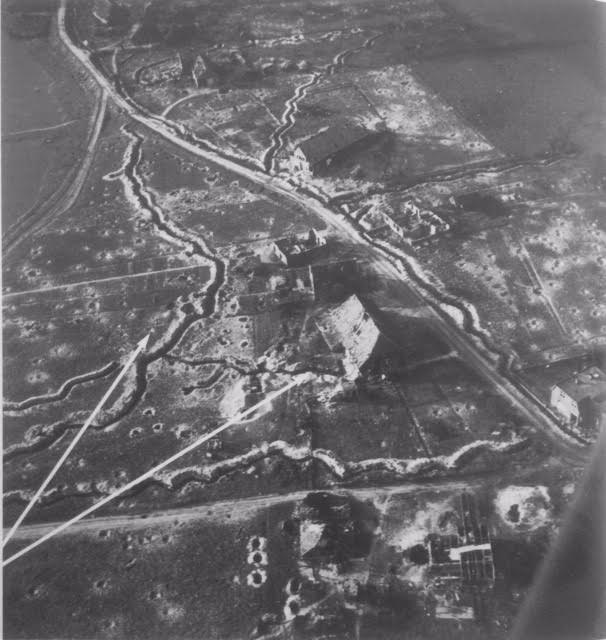 “The main and final attack was sent in from this position on a large brick building …” An aerial view of the Siegfried Line at Veen. B Company’s two-platoon attack originated from the trench running north and south [arrow on the left] against the large building in the centre [arrow on the right].
“The main and final attack was sent in from this position on a large brick building …” An aerial view of the Siegfried Line at Veen. B Company’s two-platoon attack originated from the trench running north and south [arrow on the left] against the large building in the centre [arrow on the right].
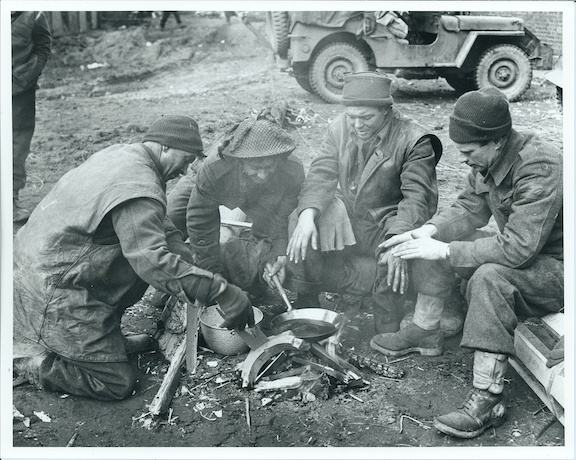 Argylls warming up and cooking after the attack on Veen, 7 March 1945: Pte Bob Fessey, Pte G.J. Burt, Pte K.L. McKenney, and Pte L.R.Young.
Argylls warming up and cooking after the attack on Veen, 7 March 1945: Pte Bob Fessey, Pte G.J. Burt, Pte K.L. McKenney, and Pte L.R.Young.
 Daisy Craven’s Windsor home before its 1961 facelift.
Daisy Craven’s Windsor home before its 1961 facelift.
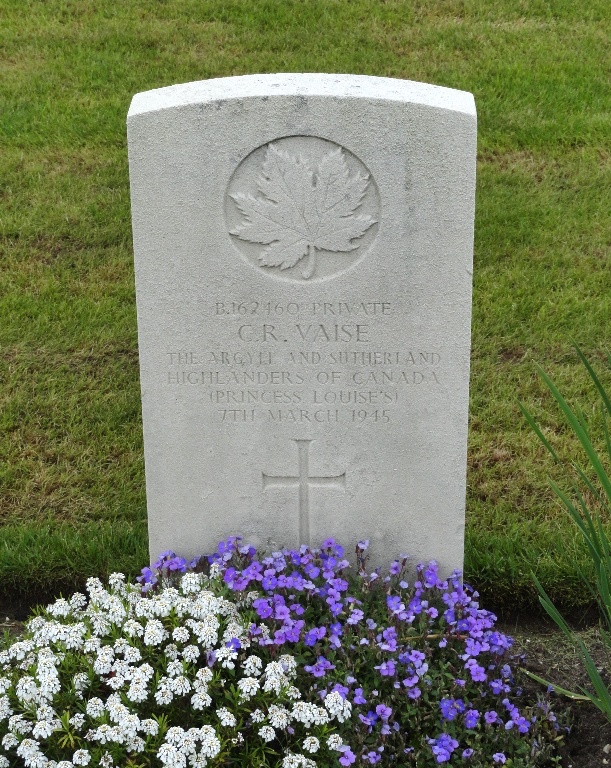 Gravestone, Pte Clarence Richard Vaise.
Gravestone, Pte Clarence Richard Vaise.